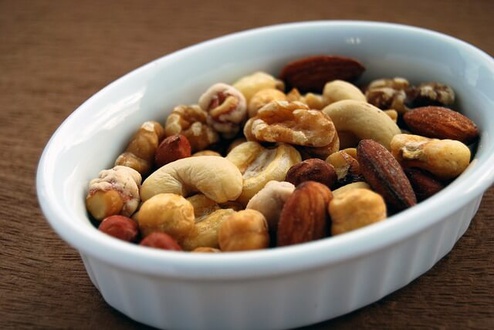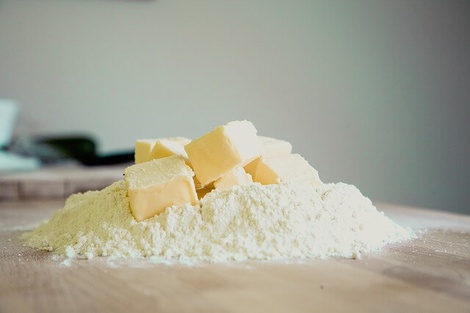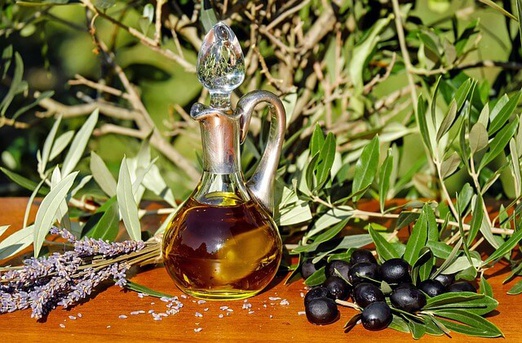Les lipides, les graisses et les huiles
Les acides gras constituent les plus petits composants des lipides. Au sein de notre organisme, les acides gras jouent trois grands rôles :
- un rôle énergétique : dans ce cas, ils sont stockés dans les cellules sous forme de triglycérides où ils sont disponibles et utilisables en cas de besoin.
- un rôle de structure : sous forme de phospholipides ils participent à la constitution des membranes cellulaires et des tissus nerveux où ils régulent le passage des substances entrantes ou sortantes des cellules.
- un rôle hormonal : ici, ils sont transformés en d’autres substances à caractère hormonal appelées éicosanoïdes. Ils agissent sur l’équilibre des systèmes immunitaire et hormonal, sur la régulation de la circulation sanguine ainsi que sur le contrôle des phénomènes inflammatoires et allergiques.
Les acides gras sont naturellement présents dans l’alimentation (fruits, légumes, viandes, poissons) ou alors ils sont extraits de ces divers aliments et transformés en huiles végétales, beurre, margarine….
Parmi les acides gras, certains sont dits essentiels et doivent être amenés par l’alimentation, en particulier l’acide linoléique ou Ω-6 (oméga-6) et ses dérivés, ainsi que l’acide alpha linolénique ou Ω-3 (oméga-3) et ses dérivés.
Il est actuellement unanimement admis et reconnu qu’un mauvais usage des lipides et des graisses constitue un facteur de risques alimentaires.
Qu’en est-il réellement ? Tentons de faire le point !
Les lipides et les graisses ou acides gras
Parmi les matières grasses, on distingue 3 groupes d’acides gras (AG) qui se classent en fonction du nombre de doubles liaisons présentes dans leur structure.
1. Les acides gras saturés (solides à température ambiante)
Les AG saturés ne présentent aucune double liaison et sont surtout d’origine animale. Leur consommation doit être régulière, mais sans excès. On les trouve surtout dans les viandes et les charcuteries, dans le beurre, la crème fraîche, les fromages, les produits laitiers, les œufs, mais aussi dans l’huile d’arachide.
Ils favorisent la synthèse de cholestérol (surtout le mauvais), l’augmentation du taux de graisses athérogènes et l’excès de poids. Dans notre alimentation actuelle, nous consommons généralement trop d’acides gras saturés, ce qui favorise l’obésité, les pathologies cardio-vasculaires (action athérogène et thrombogène), les pathologies inflammatoires et certains cancers.
Il reste cependant nécessaire d’en consommer, car ces lipides jouent un rôle important dans les structures des membranes cellulaires du système nerveux central. Leurs apports sont essentiels chez l’enfant et la femme enceinte.
Remarques :
- Le beurre frais, fermier et biologique, est à consommer pour ses apports nutritionnels, mais avec modération. Il recèle une grande variété d’acides gras et contient de la vitamine A et D (indiquées tout particulièrement pour les enfants). Contrairement aux autres graisses animales, son point de fusion est très bas, inférieur à la température du corps, ce qui en facilite la digestion. Pour bénéficier pleinement de ses qualités nutritionnelles, il est indispensable de le manger cru (éviter de le cuire). Il est à proscrire lorsqu’il y a risque de maladies cardio-vasculaires. Au vu de différentes études, le beurre et la crème fraîche apparaissent comme les plus propices à l’agrégation plaquettaire. Ce phénomène favorise l’infarctus, la thrombose des artères cérébrales, les phlébites et les troubles du rythme cardiaque. N’oubliez pas que le beurre et la crème fraîche sont généralement présents dans les pâtisseries, les biscuits et autres viennoiseries.
- La plupart du temps, les margarines résultent du mélange de plusieurs huiles ou graisses, d’origine animale ou végétale, saturées. Les margarines végétales sont presque toutes hydrogénées afin de leur faire perdre leur caractère fluide et par la même occasion toutes leurs propriétés bénéfiques (acides gras « trans »). Souvent, elles contiennent divers additifs.
Ces remarques s’appliquent aussi pour tous les produits dits allégés.
Dès lors, remplacer le beurre, aliment naturel vitaminé, au profit des margarines ou de produits tartinables et dits « allégés », comme le préconisent actuellement de nombreuses publicités et soi-disant conseils diététiques (une escroquerie de plus !), ne représente donc pas un grand bénéfice pour la santé, bien au contraire.
Où trouver les graisses saturées (origine animale & origine végétale) ?
Les viandes les + grasses :
- Le porc
- Les charcuteries
- Le mouton et l’agneau
- Le bœuf
- Huile de coco
- Huile de palme
- Huile de coprah
- Huile d’arachide
Les viandes les + maigres :
- Les volailles
Les produits laitiers :
- Le beurre
- La crème fraîche
- Les fromages…
2. Les acides gras mono insaturés ou « oméga-9 » (acide oléique)
Les AG mono-insaturés non essentiels présentent une seule double liaison et sont intermédiaires entre les AG saturés et les AG poly insaturés. Présent surtout dans l’huile d’olive, l’acide oléique se trouve également dans l’huile de colza et de sésame ainsi que dans les confits d’oie et de canard.
Ces oméga-9 possèdent des propriétés protectrices au niveau cardio-vasculaire car ils ont une action antithrombogène. Leur consommation entraîne une diminution du LDL cholestérol (mauvais cholestérol) et une augmentation du HDL cholestérol (bon cholestérol).
Ils stimulent aussi la sécrétion biliaire, facilitant ainsi la digestion et diminuant le risque de calculs biliaires.
3. Les acides gras poly insaturés
Ils présentent plusieurs doubles liaisons. Ce sont justement ces doubles liaisons qui constituent les atouts santé de ce type d’AG. Ce type d’AG se retrouve dans les huiles végétales.
Toute la problématique se situe à ce niveau puisqu’il existe 2 types d’acides gras poly insaturés dont les effets sur la santé s’opposent.
Les AG gras poly insaturés sont les constituants majeurs de toutes les membranes cellulaires (phospholipides) et particulièrement de la substance grise du cerveau, ils sont absolument indispensables pour en maintenir l’intégrité et le bon fonctionnement.
Comme ils ne peuvent être synthétisés par l’organisme humain, ils sont dits « essentiels » et doivent impérativement être fournis par l’alimentation et/ou par la supplémentation.
Sous peine de développer une carence en vitamine E, toute supplémentation en acides gras poly insaturés devrait être accompagnée d’une prise supplémentaire de vitamine E ou d’un complexe d’antioxydant qui en empêchera l’oxydation.
Les rares AG poly insaturés essentiels (AGE) apportés par l’alimentation sont présents dans les fruits oléagineux et les graines (tournesol, carthame, sésame, soja, noix, germe de blé, germe de maïs, pépin de raisin, soja, lin), dans les huiles première pression à froid ainsi que dans les poissons et leurs huiles.
Il faut distinguer :
Les acides gras poly insaturés de la série des oméga-6 (ω-6)
Les acides gras poly insaturés de la série des oméga-6 dont le chef de file est l’acide linoléique (acides gras essentiels = AGE), se trouvent en abondance dans notre alimentation courante et en particulier dans la plupart des huiles végétales à l’exception de l’huile d’olive (ω-9).
On trouve des ω-6 dans l’huile de carthame (79 %), de tournesol (69 %), de pépins de raisin, de soja, de noix (60 %), de maïs (61 %), de colza, mais également dans l’huile de bourrache et d’onagre. L’apport journalier recommandé en acide linoléique est de 8,5 à 17 g par jour.
Ils sont essentiels à la structure de la peau, jouent un rôle anti-inflammatoire et l’acide gamma linolénique (huile d’onagre) réduit les symptômes du syndrome prémenstruel.
a) Le phénomène d’oxydation
Malheureusement, les acides gras ω-6 sont très sensibles à l’oxydation et génèrent beaucoup de radicaux libres qui s’attaquent aux membranes cellulaires, au matériel génétique (ADN), et qui accentuent les réactions inflammatoires. C’est pourquoi les ω-6 deviennent NOCIFS s’ils sont absorbés en trop grande quantité.
b) Les acides gras TRANS
Par diverses transformations, notamment par hydrogénation qui vise à les rendre plus solides (exemple : la margarine), la structure de ces ω-6 se transforme et aboutit à une structure biochimique non reconnue par l’organisme : la forme TRANS.
Cette forme « trans » est rarement présente telle quelle dans la nature.
Vous en trouverez dans les produits laitiers, la graisse et la viande de bœuf et de mouton, ainsi que dans les huiles et les margarines raffinées ou hydrogénées, les pâtes ou chocolats à tartiner, les plats préparés, les pâtisseries et les biscuits salés ou sucrés, en bref dans de nombreux produits industriels dénaturés et transformés.
Le raffinage fait non seulement pivoter les molécules de la forme « cis » (physiologique) vers la forme « trans » (non physiologique), mais donne aussi lieu à la suppression ou à la transformation des éléments à haute valeur nutritionnelle tels que : protéines, acides gras, vitamines (surtout E et F), minéraux, oligo-éléments et fibres.
Afin d’éviter ce type d’acides gras « non physiologiques » et mal tolérés par l’organisme, lisez attentivement les étiquettes des produits que vous achetez. Évitez celles qui mentionnent cette phrase : « matières grasses végétales (partiellement) hydrogénées »
D’un point de vue organique et cellulaire, les acides gras sous forme « trans » jouent un rôle similaire aux acides gras saturés et doivent donc absolument être évités.
Les études les plus récentes démontrent que ces acides gras de forme TRANS :
- Augmentent la viscosité du sang (effet thrombogène),
- Diminuent le HDL cholestérol (bon cholestérol),
- Perturbent le rythme cardiaque,
- Affaiblissent le système immunitaire (augmentation du risque de cancer du sein et de la prostate),
- Augmentent le nombre de spermatozoïdes anormaux.
Par contre, la forme CIS, est la forme biologique la plus abondante dans la nature, elle constitue la seule forme assimilable par l’organisme et donc essentielle pour l’homme. Au plus les membranes cellulaires sont riches en acides gras CIS poly insaturés à longue chaîne (Acide Arachidonique, EPA et DHA), au plus elles sont souples et favoriseront les échanges physiologiques optimaux.
Les acides gras poly insaturés de la série des oméga-3 (ω-3)

a) Les acides gras poly insaturés dits essentiels
L’acide alpha linolénique et l’acide linoléique
Pour fonctionner harmonieusement, le corps a besoin d’acides gras polyinsaturés non essentiels, car ce sont eux qui donneront naissance aux acides gras polyinsaturés essentiels.
Ils peuvent se trouver tels quels dans notre alimentation, mais ils y sont très rarement présents. Ces deux chefs de file de cette catégorie seront normalement transformés par notre organisme en acide éicosapentanoïque (EPA), acide gras essentiel.
L’acide gras alpha linolénique est présent dans quelques rares huiles végétales (lin, périlla, rose musquée) dont la consommation n’est pas très courante.
L’huile de noix et de colza en recèlent également en très petite quantité.
Ce qui complique les choses, c’est que se sont les mêmes enzymes, les mêmes vitamines (vitamine B3, B6, C, E) et les mêmes minéraux (magnésium et zinc) qui régissent le métabolisme des oméga-3 et des oméga-6. Or l’excès alimentaire d’omégas-6 accapare ces enzymes, vitamines et minéraux à son seul profit, empêchant ainsi la transformation de l’acide alpha linolénique en EPA puis en DHA.
L’acide éicosapentanoïque (EPA)
Au sein de l’alimentation, il est uniquement présent dans certains poissons gras. Le poisson le plus riche en EPA et DHA est le maquereau, viennent ensuite le hareng, les anchois, la sardine, le saumon, le thon et le rouget. Le maquereau en est presque deux fois plus riche que le saumon et le flétan. L’encornet, les crevettes, les homards et les coquillages de mer constituent d’autres sources d’oméga-3.
Les scientifiques avaient remarqué depuis longtemps que les grands consommateurs de poissons (Esquimaux, Japonais, par exemple) sont nettement moins touchés par les maladies cardiovasculaires. L’explication provient du fait que l’EPA se transforme en éicosanoïdes de série 3 qui contribuent à la protection des artères et du cœur. Les études scientifiques lui attribuent la plupart des effets bénéfiques des omégas-3.
Il peut également provenir de la conversion de l’acide alpha linolénique issue des huiles végétales. Cependant, beaucoup d’études scientifiques attribuent l’effet bénéfique au seul EPA exclusivement issu des huiles de poisson.
L’acide docosahexanoïque (DHA)
Également présent tel quel dans les poissons gras, il peut aussi résulter de la conversion de l’EPA, mais encore faut-il que celui-ci soit présent en quantité suffisante au sein de notre organisme. Le DHA est indispensable au bon développement du cerveau et de la rétine. Il sera surtout utile chez la femme enceinte.
Les 2 types principaux d’AG polyinsaturés essentiels (AGE)
APPELLATION ORIGINE
Oméga-3 = ω-3 Surtout dans les poissons dits « gras = acide a-linolénique
———————————————(maquereau, hareng, saumon) et leurs huiles, mais aussi
———————————————présents dans certaines huiles végétales
- Huile de lin
- Soja
- Noix
Oméga-6 = ω-6 Surtout dans les huiles végétales = acide linoléique
- Tournesol
- Carthame
- Soja
- Maïs
- Germe de blé
b) La raréfaction des ω-3 dans notre alimentation
Depuis 4 millions d’années, les hommes étaient des chasseurs – cueilleurs. Le menu paléolithique était composé de poissons, de viandes ainsi que de fruits et de végétaux. Notre patrimoine génétique s’est donc adapté à l’équilibre en acides gras essentiels des plantes et des animaux sauvages.
Progressivement, la consommation de poissons et de végétaux a diminué au profit des céréales et du pain ainsi que des produits laitiers. Ainsi il apparaît que, depuis la guerre, le changement essentiel dans notre alimentation de type occidental est l’augmentation croissante de notre consommation en ω-6 manipulés (formes trans) au détriment d’une diminution de l’absorption des ω-3. On pourrait citer de nombreux exemples pour illustrer cette dérive des omégas-3 vers les omégas-6. Prenons simplement l’exemple des œufs : des poules élevées en plein air qui se nourrissent de plantes vertes pondent des œufs avec un rapport ω6 ⁄ω3 = 1. Tandis que des poules d’élevage nourries au maïs pondent des œufs avec un rapport ω6 ⁄ω3 = 20 ! De cette modification progressive de notre régime alimentaire résulte un appauvrissement très important des apports en oméga-3.
Les apports journaliers conseillés pour l’acide alpha linolénique sont de 1,4 à 2,8 g par jour.
Un ratio de 4/1 en ω-6 et ω-3 apparaît comme un ratio fonctionnel optimum. Actuellement, le régime alimentaire occidental se caractérise par des ratios allant de 10/1, 25/1 à 40/1.

c) Quels sont les rôles et les actions des ω-3
Au vu de plusieurs centaines d’études scientifiques consacrées aux Oméga-3 et de ma propre expérience médicale, je conclus sans aucun doute que les acides gras de type oméga-3 préviennent effectivement bien les grandes maladies dégénératives tout en assurant un fonctionnement optimal du cerveau. A condition bien sûr de les choisir de bonne qualité et d’origine certaine.
L‘action des Omega-3 surtout résulte des effets des éicosanoïdes qu’ils contiennent. Les omégas-6 contiennent également des éicosanoïdes, mais ces derniers s’opposent à ceux issus de la famille oméga-3.
Prévention des maladies cardio-vasculaires
- L’action favorable des omégas-3 sur divers facteurs en rapport avec la sphère cardiaque a été démontrée par des centaines d’études cliniques. Ainsi, ils agissent plus particulièrement sur :
- L’élasticité des vaisseaux,
- La diminution de l’agrégation des plaquettes sanguines,
- La diminution de la viscosité sanguine avec augmentation de la déformabilité des hématies et augmentation de la fluidité des membranes (augmente le flux sanguin),
- La baisse du fibrinogène, substance intervenant dans la coagulation du sang,
- La stimulation l’activité fibrinolytique (dissolution des caillots),
- La diminution la tension artérielle,
- Les troubles du rythme cardiaque
- La diminution des taux de triglycérides (acides gras circulants),
- La régulation des taux de cholestérol notamment en augmentant le « bon cholestérol » (HDL).
Prévention du cancer
D’autres recherches ont prouvé l’action préventive des omégas-3 sur les cancers du sein, de la prostate, du poumon, du pancréas et du colon. Cette action préventive s’étend plus que probablement à l’ensemble des cancers. A l’inverse, des études récentes démontrent que les omégas-6 agissent sur l’expression des gènes qui augmentent la production de protéines promotrices du cancer tandis que les omégas-3 inactivent cette protéine.
Action sur le diabète
Les acides gras omégas-3 rendent les membranes cellulaires plus fluides entraînant une augmentation du nombre de récepteurs à l’insuline et donc une meilleure action de l’insuline au niveau des cellules.
La santé mentale
De très nombreuses études cliniques ont permis de démontrer que les omégas-3 augmentent les facultés d’apprentissage et la mémoire. Ils permettent de diminuer le nombre et la gravité des dépressions, atténuent les symptômes de la schizophrénie et diminuent les risques de maladie d’Alzheimer. On a également constaté un effet très bénéfique d’une supplémentation en omégas-3 chez les enfants dits « hyperactifs ».
Maladies inflammatoires, allergiques et auto-immunes
Une augmentation de la consommation d’omégas-3 associée à une réduction des omégas-6 diminue le risque et/ou réduit la sévérité de nombreuses maladies inflammatoires, allergiques ou auto-immunes comme les arthrites, les maladies pulmonaires chroniques, l’asthme, le psoriasis, la maladie de Crohn, le lupus….
Un apport en ω-3 stimulerait le système immunitaire tout en réduisant les facteurs inflammatoires.
Effet global sur le corps
Les ω-3 freinent l’action nocive des radicaux libres sur les cellules et améliorent les performances physiques et intellectuelles.
Une dernière remarque essentielle sans aucun doute formulée plus à l’attention des dames soucieuses de leur silhouette : les omégas-3 ne font pas grossir et favorisent même la perte de poids. En effet, ils améliorent l’utilisation des sucres par les cellules, ils freinent la fabrication des graisses par l’organisme tout en contribuant à leur combustion.
d) Comment retrouver l’équilibre ω-3 / ω-6 ?
1. Il faut tout d’abord diminuer sa consommation d’omégas-6, ce qui n’est pas facile puisque notre alimentation moderne en contient énormément. Evitez donc la plupart des huiles végétales (arachide, tournesol, carthame, maïs) et privilégiez plutôt l’huile d’olive pour son apport oméga-9.
2. Il faut augmenter sa consommation d’omégas-3, ce qui n’est pas facile non plus puisque notre alimentation moderne en contient très peu. Outre les huiles de lin et de périlla, difficiles à trouver et chères pour une utilisation quotidienne en tant qu’huile alimentaire, on trouve des omégas-3 dans certains légumes verts comme le pourpier et la roquette, mais surtout dans la chair des poissons gras comme le maquereau, le hareng, la sardine, le saumon et le thon.
N’oublions pas que le rapport ω-6/ω-3 conseillé est de 4.

• Est-il préférable de manger du poisson ou de prendre des suppléments d’omégas-3 ?
Plusieurs problèmes se posent avec le poisson. Premièrement, tout le monde n’est pas prêt à consommer minimum 3 fois par semaine du maquereau ou du hareng. Deuxièmement, beaucoup de poissons comme le saumon sont des poissons d’élevage qui contiennent moins d’omégas-3 que les poissons sauvages. Troisièmement, les poissons sauvages sont des éponges à toxiques et concentrent dans leur chair la pollution (mercure) de nos mers et de nos rivières. Finalement, la prise d’omégas-3 sous forme de complément alimentaire est la solution la plus simple et surtout la plus efficace à condition de trouver un produit de qualité.
• Bien choisir son supplément en omégas-3
De nombreuses sociétés de produits naturels proposent aujourd’hui des compléments nutritionnels aux omégas-3 à base d’huile de poisson, cependant ils ne sont pas tous équivalents ni en qualité, ni en apport nutritionnel.
Voici la liste des critères essentiels pour être certain de bénéficier d’un produit de qualité :
- L’huile de poisson doit contenir minimum 70 % d’omégas-3.
- Le rapport idéal entre EPA et DHA est 70/10, car la plupart des effets bénéfiques sont attribués à l’EPA.
- L’huile doit être de qualité pharmaceutique et donc certifiée sans dioxines ou métaux lourds.
- Elle doit contenir de la vitamine E, mais sous forme d’alpha-tocophérol plutôt que sous une autre forme, car c’est l’antioxydant majeur au niveau des membranes cellulaires, ce qui permet d’éviter l’oxydation des omégas-3 à l’intérieur de l’organisme.
Du bon usage des lipides en général
L’alimentation lipidique doit respecter les critères suivants :
1) Elle doit être sans excès.
Les excès favorisent :
- l’obésité
- le diabète
- l’hypercholestérolémie
- la thrombose
2) Elle doit cependant être suffisante.
Le régime hypolipidique diminue le cholestérol total, mais surtout le HDL (bon cholestérol), ce qui est défavorable sur le plan cardio-vasculaire.
3) Elle doit être non thrombogène.
Il faut donc éviter :
- l’excès de graisses saturées
- l’excès d’acides gras ω-6
- l’insuffisance d’acides gras ω-3
Les huiles végétales alimentaires
Les huiles végétales contiennent des acides gras de différents types. Il faut en varier la consommation afin d’obtenir des apports équilibrés de chaque type d’acides gras. Rappelons qu’elles doivent être vierges et obtenues par première pression à froid (VPPF) afin de conserver toutes leurs qualités nutritionnelles. Celles-ci sont pressées à des températures voisines de 30 °C. Elles contiennent des acides gras essentiels, en particulier l’acide a-linolénique et l’acide linoléique. Ces acides gras sont parfois repris sous le nom de vitamine F. Rappelons qu’il est indispensable de les consommer avec leurs propriétés initiales, c’est-à-dire sous leur forme naturelle « cis ». Ce type d’extraction à froid est indispensable pour bénéficier de leurs propriétés antioxydantes et des vitamines F et E.
La mention « Vierge » signifie qu’aucun solvant ou autre produit chimique n’ont été rajoutés afin d’augmenter le rendement de production, mais cela ne signifie pas que l’huile a été obtenue par un procédé de pression à froid.
En effet, cette mention « vierge » seule ne suffit pas à la garantie du consommateur, elle doit être complétée par la mention « première pression à froid ».
L’utilisation pratique des huiles végétales en cuisine
- Les acides gras saturés (huile d’arachide) et mono-insaturés (huile d’olive) résistent bien aux hautes températures. Ils peuvent donc être utilisés pour les cuissons et les fritures. Il faut cependant donner la préférence à l’huile d’olive, bien meilleure pour la santé que l’huile d’arachide.
- Les acides gras polyinsaturés ω-3 et ω-6 s’oxydent avec la cuisson, et donnent alors naissance à des radicaux libres toxiques. Il existe deux exceptions : l’huile de tournesol et l’huile de pépins de raisin, toutes les deux très stables, et qui peuvent être chauffées respectivement jusqu’à 160° et 220° degrés, sans être altérées. Il est donc préférable de réserver les huiles végétales contenant des acides gras polyinsaturés aux vinaigrettes et assaisonnements froids.





